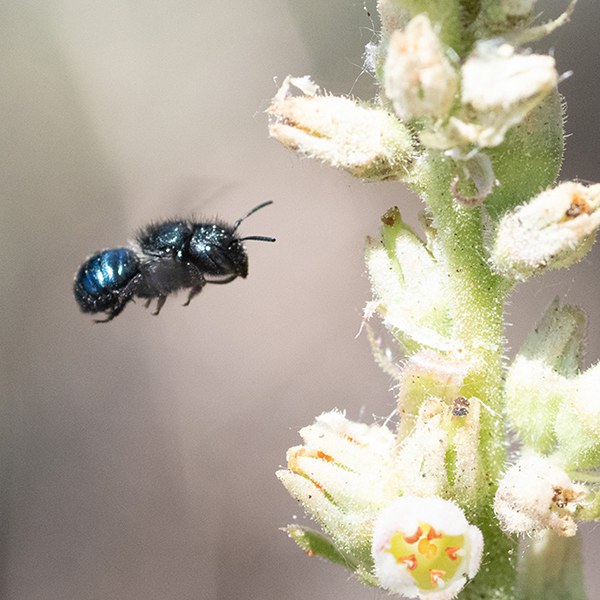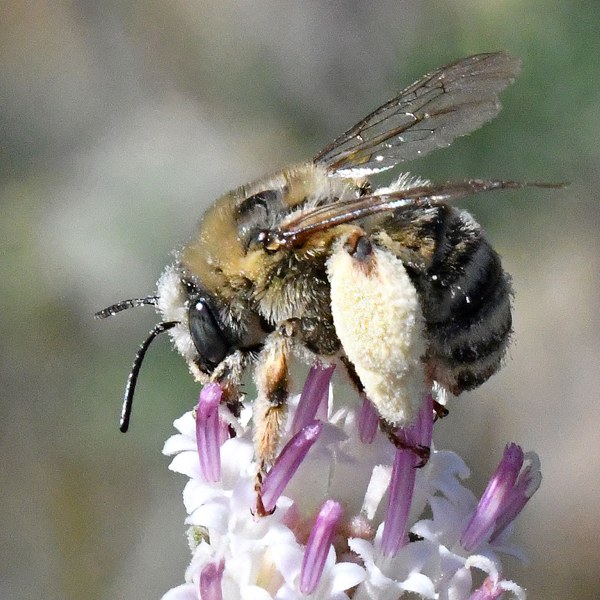How can it be possible that there’s SO MUCH information out there about bees, yet we also know so little about bees? We know that more than 700 species of bees call Oregon home. However, we don’t know exactly how many species there actually are, something the Oregon Bee Atlas is hard at work trying to remedy. Let’s make a bee line to some interesting things to know about bees!
What makes a bee, a bee? Let’s get started with the basics. You’ll know you’re looking at a bee if the insect has:
- Eyes on the side of its head
- Two pairs of wings
- Long “elbowed” antennae
- Fuzz or hairs that collect pollen
Does it have to be yellow and black? Nope. What about being a social creature? Not that either.
To get a better idea of the variety of bees in Oregon, take a look at a sampling of some bees (both native and non-native) from the Insect Lab at the Oregon Department of Agriculture. Bumble bees, sweat bees, and even the pugnacious leaf-cutter bee!
It’s time to talk about the European honey bee. Apis mellifera, also known as the European honey bee or the western honey bee, is not native to the United States. European settlers brought over the European honey bee in the 1620s. Why would they do that? For honey! European honey bees are known for their honey collection. Today, they are the most widely used commercial pollinator in the world! I’ll leave you with one more fun fact about European honey bees—all of the worker bees are female! That’s right, women run the honey bee world.

What about native bee pollination? If European honey bees didn’t arrive in the US until the 1620s, clearly the native bees were doing a fine job of pollinating before that (and continue to do a good job!). Our gardens, wildflowers, and yards are continually pollinated by native bees during the growing season. In fact, bumble bees are known to be great at pollinating tomatoes and peppers, as they buzz the flower to shake the pollen loose. There are also other native bees that specialize in pollinating specific plants and wildflowers, making them exceptionally good at what they do.

Insect introverts. That’s right, it’s time to curl up on the couch with a good book. Many native bees are solitary bees. This is in sharp contrast to honey bees, which have colonies (quick fact: the average hive size of the European honey bee is 25,000). As the name implies, solitary bees live on their own. There are solitary bees that may nest in large groups, but they do not actively help one another. Of course, there are some native bees that are social, including bumble bees and some species of sweat bees and carpenter bees.
We hope you are buzzing with excitement about all of these bee facts! Join us for our January 24th Nature Night, The Remarkable Bees of Central Oregon, either in-person at the Tower Theatre in downtown Bend, or via livestream (perhaps channeling the solitary bee experience). Tickets are free, but registration is required for both in-person or livestream. Register today!
Sources:
- Common Bees Pollinators of Oregon Crops, Oregon Department of Agriculture
- Native Bees, Solitary Bees, and Wild Bees: What are they?, University of Minnesota Extension
- Frequently Asked Questions, Oregon Bee Project
- Basic Bee ID, University of Minnesota Extension
Learn more:
- Register for the Land Trust's January 24th Nature Night, The Remarkable Bees of Central Oregon
- Surveying Oregon's Native Bees
- Pollinators of Central Oregon
- Preparing Your Yard or Garden for Winter


